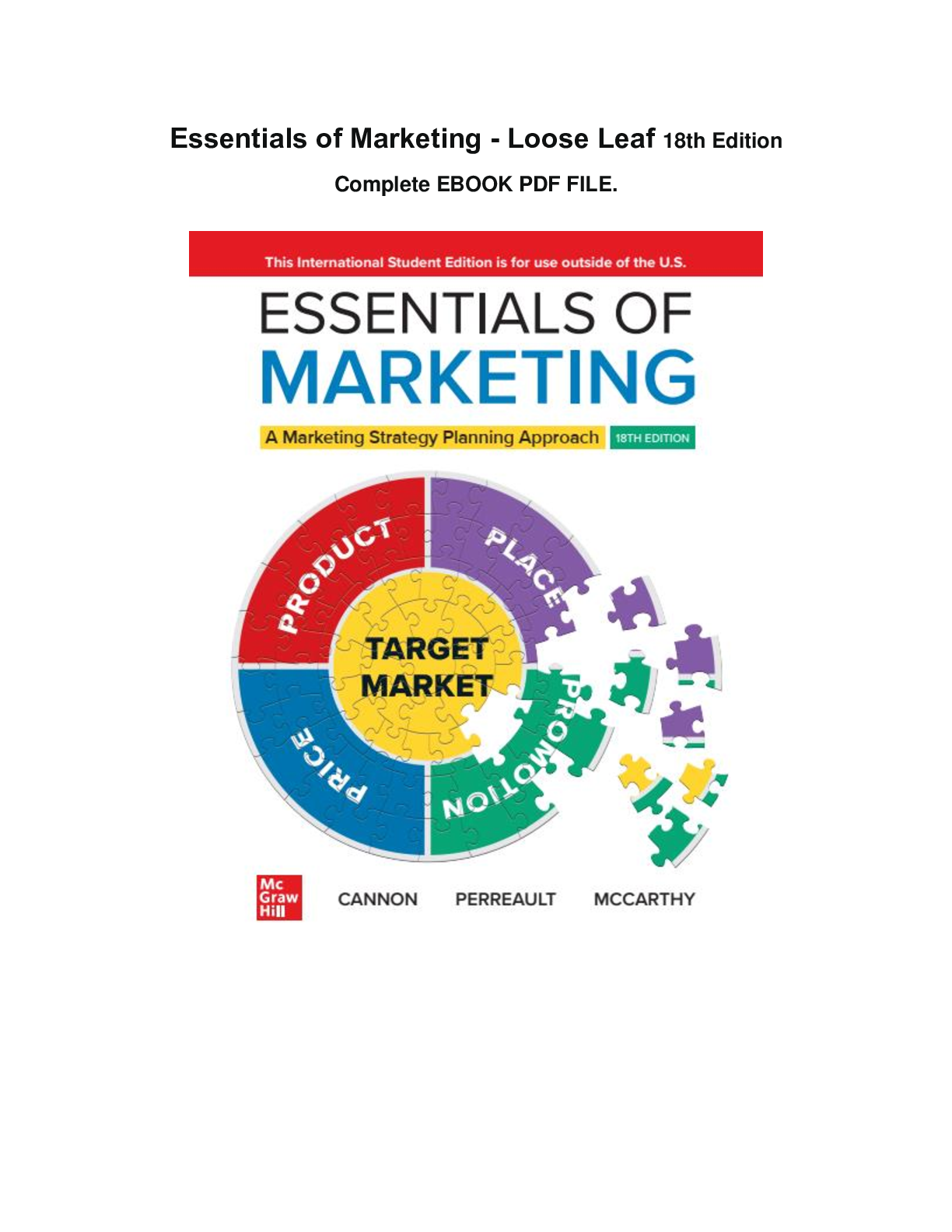Medical Studies > eBook-PDF > Foundations of Neural Development, 1st Edition By Marc Breedlove | [eBook] [PDF] (All)
Foundations of Neural Development, 1st Edition By Marc Breedlove | [eBook] [PDF]
Document Content and Description Below
Foundations of Neural Development, 1st Edition By Marc Breedlove | [eBook] [PDF] Front Matter Copyright Page Dedication Brief Contents Contents Preface Media & Supplements Prologue: The Rat... ionalist Philosophers All I Know Is That I Know Nothing The Benefits of Having an Immortal Soul What Does All This Philosophy Stuff Have to Do with This Book? Chapter 1 Cell Differentiation and Neural Induction 1.1 Metazoans Evolved the Ability to Produce Cells with Very Different Functions 1.2 Preformationism Offered an Easy but Wrong Solution, While Epigenesis Seemed Incomprehensible 1.3 the Rediscovery of Genes Set the Stage for Understanding Development 1.4 Gene Expression Directs Cell Differentiation 1.5 Scientists Domesticated a Simple Worm to Address the Questions of Cell Differentiation 1.6 Mitotic Lineage Guides Cell Differentiation in Worms 1.7 Embryonic Development Begins by Forming Three Distinct Germ Layers 1.8 the Vertebrate Nervous System Begins as a Simple Tube 1.9 Many Embryos, Including All Vertebrates, Display “self-regulation” 1.10 Self-regulation Seems Incompatible with Mitotic Lineage–directed Differentiation 1.11 Experimental Embryology Revealed Inductive Processes Underlying Self-regulation 1.12 a Region of the Vertebrate Embryo Seems to “organize” Development 1.13 Long Abandoned, the Organizer Was Uncovered Through Molecular Biological Techniques 1.14 What Organizes the Organizer? 1.15 in Insects, Epidermal Cells Compete to Become Neuroblasts Summary Chapter 2 Development of a Body Pattern 2.1 Darwin Noted That Vertebrate Embryos Start Off Looking Alike 2.2 Mother Knows Best: Maternal Factors Establish a Basic Polarity of the Body 2.3 A Cascade of Gene Regulatory Proteins Organizes a Body Plan 2.4 Some Mutations in Drosophila Transform Body Parts Whole 2.5 Hox Genes Are Crucial for Vertebrate Development, Too 2.6 Hox Genes Direct “segmentation” in the Mammalian Brain 2.7 Hindbrain Rhombomere Fates Are Directed by Homeobox Genes 2.8 Several Signals Designate the Caudal End of the Body and Nervous System 2.9 Continued Gradients in Bmp Signaling Establish the Dorsal-ventral Axis in the Nervous System 2.10 Find Out Where You Are to Coordinate Your Fate with That of Your Neighbors Summary Chapter 3 Neurogenesis and Migration 3.1 the Same Gene May Play a Role in Many Different Developmental Events 3.2 the Developing Brain Generates Neurons at a Tremendous Rate 3.3 Shortly After Division, Neural Cells Diverge to Become Neurons or Glia 3.4 the Cerebellum and Cerebral Cortex Form in Layers 3.5 We Can Label Newly Synthesized Dna to Determine the Birthdates of Cells 3.6 Newborn Cells Shinny Up Glial Poles 3.7 a Few Brain Regions Display Continuing Neurogenesis Throughout Life 3.8 Neural Crest Cells Migrate to Positions Throughout the Body 3.9 Cell Adhesion Molecules Attract and Repel Migrating Cells 3.10 Cerebellar Granule Cells Parachute Down from Above 3.11 Cells Crucial for Smell and Reproduction Migrate into the Embryonic Brain Summary Chapter 4 Neural Differentiation 4.1 the Fruit Fly Retina Develops Through an Orderly Progression of Gene Expression and Signaling 4.2 Several Factors Influence Whether a Cell Will Become a Neuron or a Glia 4.3 the Molecular Differentiation of Motor Neurons Is Orderly 4.4 Neural Crest Cells Are Affected by Their Migration and Destination 4.5 the Neurotransmitter Phenotypes of Autonomic Neurons Are Guided by Their Targets 4.6 the Fate of a Cortical Neuron Is Influenced Both Before and After Migration 4.7 Later Events in Development Are More Evolutionarily Labile Summary Chapter 5 Axonal Pathfinding 5.1 Ramón Y Cajal Described Growth Cones and Discerned Their Significance 5.2 in Vitro Approaches Reveal Principles of Axonal Growth and Adhesion 5.3 Guidance Cues May Be Attractive to One Type of Growth Cone and Repulsive to Others 5.4 Families of Receptors Offer a Multitude of Guidance Cues 5.5 Pioneer Neurons and Guidepost Cells Establish Pathways for Later Axons 5.6 Many Axonal Growth Cones Have to Deal with Crossing the Midline 5.7 Motor Neuronal Axons Must Find the Correct Target Muscles 5.8 the Axons of Retinal Ganglion Cells Must Reach the Midbrain 5.9 the Corpus Callosum Is Directed Across the Midline by a Glial Bridge Summary Chapter 6 Synapse Formation and Maturation 6.1 Calcium Regulators and Environmental Sensors Evolved to Mediate Synaptic Signaling 6.2 We Can Divide Synapse Structure and Development into Three Parts 6.3 a Synapse Begins with Adhesion 6.4 Fragile X Syndrome Suggests There Can Be Too Much of a Good Thing 6.5 Preand Postsynaptic Partners Tightly Anchor One Another as a Synapse Develops 6.6 Neuromuscular Junctions Illustrate That Synapse Formation Is a Dance for Two (or More) 6.7 Motor Neuronal Agrin Promotes the Aggregation of Acetylcholine Receptors 6.8 Neuregulins Boost Local Achr Expression in Muscle and Maintain Terminal Schwann Cells 6.9 Once Formed, the Nmj Leaves an Imprint in the Extracellular Matrix 6.10 Ion Channels Change Subunits, and Therefore Characteristics, During Development 6.11 Embryonic Synapses Are Sluggish and Slow, Then Become Progressively Faster with Development 6.12 Myelination Extends into Adulthood to Hasten Neuronal Communication 6.13 Myelinating Glia May Prevent Regeneration in the Central Nervous System Summary Chapter 7 Apoptosis 7.1 the Death of Many Cells Is a Normal Process in Development 7.2 the Extent of Death Among Developing Motor Neurons Is Regulated by the Size of the Target 7.3 Nerve Growth Factor (ngf) Is Discovered to Regulate Apoptosis in Sensory Neurons 7.4 Ngf Has Both Tropic and Trophic Effects on Selective Neuronal Populations 7.5 the Search for Relatives of Ngf Reveals a Family of Neurotrophic Factors and Their Receptors 7.6 Studies in C. Elegans Provide Crucial Information About the Process of Apoptosis 7.7 Apoptosis Involves Active Self-destruction Through a Cascade of “death Genes” 7.8 Do Motor Neurons Die in Als for Lack of Neurotrophic Factor(s)? 7.9 Hormones Direct Sexual Differentiation of the Vertebrate Body and Behavior 7.10 the Brain Is Also Sexually Dimorphic 7.11 Hormones Can Regulate Apoptosis to Masculinize the Vertebrate Brain 7.12 Sexual Differentiation in Flies Is a Cellautonomous Process 7.13 the Controversy over Sexual Orientation in Flies, Rats, and People Summary Interlude: The Empiricists Strike Back The Tabula Rasa and the Importance of Experience Through the Senses What Does All This Philosophy Stuff Have to Do with This Book? Chapter 8 Activity-guided Neural Development 8.1 Motor Neuronal Death Is Gated by Neuronal Activity 8.2 Developing Muscle Fibers Start Off with Polyneuronal Innervation 8.3 Autonomic Neurons Refine Their Inputs and Outputs 8.4 Donald Hebb Speculated About Neural Plasticity 8.5 Long-term Potentiation (ltp) Confirms the Existence of Hebbian Synapses 8.6 a Class of Glutamate Receptors Enforces Hebbian Rules 8.7 the Brain Must Integrate Input from the Two Eyes 8.8 Even Spontaneous, Apparently Random Activity Can Provide Order 8.9 the Gray Matter of Human Cortex Thins as We Mature Chapter 9 Experience-guided Neural Development 9.1 Humans Can Adapt to Seeing the World in a New Way 9.2 Retinal Ganglion Cells in Adult Amphibians and Fish Can Reestablish Connections to the Tectum 9.3 Various Permutations of Retinotectal Regeneration Refute a Strict Version of Chemoaffinity 9.4 Visual Experience Fine-tunes Frog Retinotectal Connections 9.5 Mammals Require Visual Experience During a Sensitive Period to Develop Functional Vision 9.6 Physiological Recordings Reveal How Visual Deprivation Impairs Sight 9.7 Owls Can Use Visual Experience to Fine-tune Their Auditory Maps 9.8 Olfactory Receptor Maps Are Also Sculpted by Experience 9.9 Tactile Experience Guides the Formation of Topographic Maps in Somatosensory Cortex Chapter 10 Socially Guided Neural Development 10.1 The Terms Instinct and Innate Are So Vague That They Are Worthless 10.2 Species with Parental Behavior Develop the Most Complex Brains and Behavior 10.3 Maternal Behavior Can Regulate the Stress Response of Offspring 10.4 Many Species Look to Their Parents to Recognize Mating Partners 10.5 Observational Learning Can Transmit Behaviors Across Generations 10.6 Birdsong Is a Learned Behavior Where Young Males Model Their Father’s Song 10.7 Humans Are Predisposed to Learn Language Without Any Formal Training 10.8 Primates Require Love to Develop Properly 10.9 Postnatal Social Stimulation Continues to Affect Brain Development 10.10 Intelligence Tests Demonstrate the Pervasive Effects of Culture 10.11 the Controversial Issue of Racial Differences in Average Iq Performance Epilogue: Immanuel Kant and the Critique of Pure Reason The a Priori Embodiment of Space and Time Space Time What Does All This Philosophy Stuff Have to Do with This Book? Appendix: Basic Concepts and Important Techniques A.1 Genes Carry Information That Encodes the Synthesis of Proteins A.2 Molecular Biologists Have Craftily Enslaved Microorganisms and Enzymes A.3 Gene Editing Enables the Creation of Model Organisms Glossary References Author Index Subject Index About the Book [Show More]
Last updated: 9 months ago
Preview 1 out of 370 pages

Buy this document to get the full access instantly
Instant Download Access after purchase
Buy NowInstant download
We Accept:

Reviews( 0 )
$26.00
Can't find what you want? Try our AI powered Search
Document information
Connected school, study & course
About the document
Uploaded On
Mar 08, 2022
Number of pages
370
Written in
Additional information
This document has been written for:
Uploaded
Mar 08, 2022
Downloads
1
Views
156





















, Latest Questions and Answers with Explanations, All Correct Study Guide, Download to Score A.png)



